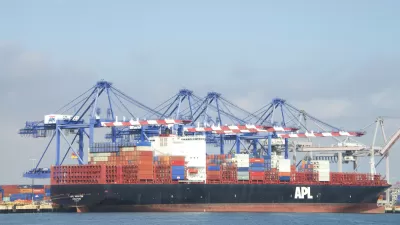Time will tell whether President Trump is able to enact any of the ambitious trade policies he proposed on the campaign trail, but research shows the cities that will prosper or suffer based on the success of those initiatives.

Ana Swanson, Ted Mellnik, and Darla Cameron report on the potential impacts on local and regional communities should President Trump achieve his policy agenda on matters of trade—"sweeping measures"
such as "writing the free-trade agreement with Canada and Mexico, or new taxes to make imports more expensive and boost competing American goods."
The article shares research by the Brookings Institution's Metropolitan Policy Program, presented visually in a map that illustrates the places in the United States "most exposed in a trade war." The map shows how dependent counties are on trade, by measuring how large a portion of the local economy is devoted to exports and how many jobs directly relate to export activity.
"While exposure to trade differs substantially across the country, every U.S. metro area has some exposure, with at least $1 out of every $20 generated in the local economy coming from exports. Most cities get much more. That means these cities have a lot to gain as well as potentially lose from major changes to trade policy," write the trio of reporters in sharing the findings of the Brookings analysis.
Interestingly, the city with the largest share of GDP devoted to exports is Columbus, Indiana, "the home base for engine-maker Cummins Inc. and other automotive manufacturers, and the hometown of Vice President Pence." That example fits a common theme in the data: counties that voted for Trump in the 2016 president election tend to have economies more devoted to exports. "According to Brookings estimates, exports make up 13 percent of local GDP in counties won by Trump, compared to 10 percent in counties won by Clinton," states the article.
FULL STORY: The places in America most exposed to a trade war

Alabama: Trump Terminates Settlements for Black Communities Harmed By Raw Sewage
Trump deemed the landmark civil rights agreement “illegal DEI and environmental justice policy.”

Study: Maui’s Plan to Convert Vacation Rentals to Long-Term Housing Could Cause Nearly $1 Billion Economic Loss
The plan would reduce visitor accommodation by 25% resulting in 1,900 jobs lost.

Why Should We Subsidize Public Transportation?
Many public transit agencies face financial stress due to rising costs, declining fare revenue, and declining subsidies. Transit advocates must provide a strong business case for increasing public transit funding.

Paris Bike Boom Leads to Steep Drop in Air Pollution
The French city’s air quality has improved dramatically in the past 20 years, coinciding with a growth in cycling.

Why Housing Costs More to Build in California Than in Texas
Hard costs like labor and materials combined with ‘soft’ costs such as permitting make building in the San Francisco Bay Area almost three times as costly as in Texas cities.

San Diego County Sees a Rise in Urban Coyotes
San Diego County experiences a rise in urban coyotes, as sightings become prevalent throughout its urban neighbourhoods and surrounding areas.
Urban Design for Planners 1: Software Tools
This six-course series explores essential urban design concepts using open source software and equips planners with the tools they need to participate fully in the urban design process.
Planning for Universal Design
Learn the tools for implementing Universal Design in planning regulations.
Smith Gee Studio
Alamo Area Metropolitan Planning Organization
City of Santa Clarita
Institute for Housing and Urban Development Studies (IHS)
City of Grandview
Harvard GSD Executive Education
Toledo-Lucas County Plan Commissions
Salt Lake City
NYU Wagner Graduate School of Public Service




























